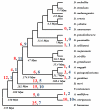U12-type spliceosomal introns of Insecta
- PMID: 22393306
- PMCID: PMC3291851
- DOI: 10.7150/ijbs.3933
U12-type spliceosomal introns of Insecta
Abstract
Most of eukaryotic genes are interrupted by introns that need to be removed from pre-mRNAs before they can perform their function. This is done by complex machinery called spliceosome. Many eukaryotes possess two separate spliceosomal systems that process separate sets of introns. The major (U2) spliceosome removes majority of introns, while minute fraction of intron repertoire is processed by the minor (U12) spliceosome. These two populations of introns are called U2-type and U12-type, respectively. The latter fall into two subtypes based on the terminal dinucleotides. The minor spliceosomal system has been lost independently in some lineages, while in some others few U12-type introns persist. We investigated twenty insect genomes in order to better understand the evolutionary dynamics of U12-type introns. Our work confirms dramatic drop of U12-type introns in Diptera, leaving these genomes just with a handful cases. This is mostly the result of intron deletion, but in a number of dipteral cases, minor type introns were switched to a major type, as well. Insect genes that harbor U12-type introns belong to several functional categories among which proteins binding ions and nucleic acids are enriched and these few categories are also overrepresented among these genes that preserved minor type introns in Diptera.
Keywords: U12-type introns; insect evolution.; minor spliceosome.
Conflict of interest statement
Conflict of Interests: The authors have declared that no conflict of interest exists.
Figures



Similar articles
-
The significant other: splicing by the minor spliceosome.Wiley Interdiscip Rev RNA. 2013 Jan-Feb;4(1):61-76. doi: 10.1002/wrna.1141. Epub 2012 Oct 16. Wiley Interdiscip Rev RNA. 2013. PMID: 23074130 Free PMC article. Review.
-
Evolutionary dynamics of U12-type spliceosomal introns.BMC Evol Biol. 2010 Feb 17;10:47. doi: 10.1186/1471-2148-10-47. BMC Evol Biol. 2010. PMID: 20163699 Free PMC article.
-
Spliceosomal small nuclear RNA genes in 11 insect genomes.RNA. 2007 Jan;13(1):5-14. doi: 10.1261/rna.259207. Epub 2006 Nov 9. RNA. 2007. PMID: 17095541 Free PMC article.
-
Expansion and transformation of the minor spliceosomal system in the slime mold Physarum polycephalum.Curr Biol. 2021 Jul 26;31(14):3125-3131.e4. doi: 10.1016/j.cub.2021.04.050. Epub 2021 May 19. Curr Biol. 2021. PMID: 34015249
-
Splicing of a rare class of introns by the U12-dependent spliceosome.Biol Chem. 2005 Aug;386(8):713-24. doi: 10.1515/BC.2005.084. Biol Chem. 2005. PMID: 16201866 Review.
Cited by
-
Where the minor things are: a pan-eukaryotic survey suggests neutral processes may explain much of minor intron evolution.Nucleic Acids Res. 2023 Nov 10;51(20):10884-10908. doi: 10.1093/nar/gkad797. Nucleic Acids Res. 2023. PMID: 37819006 Free PMC article.
-
The significant other: splicing by the minor spliceosome.Wiley Interdiscip Rev RNA. 2013 Jan-Feb;4(1):61-76. doi: 10.1002/wrna.1141. Epub 2012 Oct 16. Wiley Interdiscip Rev RNA. 2013. PMID: 23074130 Free PMC article. Review.
-
An Integrated Model of Minor Intron Emergence and Conservation.Front Genet. 2019 Nov 13;10:1113. doi: 10.3389/fgene.2019.01113. eCollection 2019. Front Genet. 2019. PMID: 31798628 Free PMC article.
References
-
- Gilbert W. Why genes in pieces? Nature. 1978;271:501. - PubMed
-
- Crick F. Split genes and RNA splicing. Science. 1979;204:264–71. - PubMed
-
- Burge CB, Tuschl T, Sharp P.A. Splicing of precursors to mRNAs by the Spliceosome. In: Gesteland RF, Cech TR, Atkins JF, editors. RNA world. New York, USA: Cold Spring Harbor Laboratory Press; 1999. pp. 525–60.
-
- Lamond AI. The spliceosome. Bioessays. 1993;15:595–603. doi:10.1002/bies.950150905. - PubMed
Publication types
MeSH terms
Substances
LinkOut - more resources
Full Text Sources
Molecular Biology Databases

